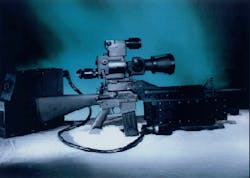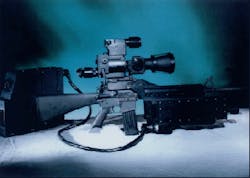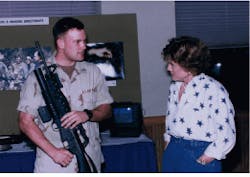Vienna meeting sets ban on blinding laser weapons
Vienna meeting sets ban on blinding laser weapons
US policy reversal results in international protocol banning blinding lasers, but loopholes still remain.
William M. Arkin
In a stunning reversal of a 22-year-old policy allowing use of laser weaponry on the battlefield, the United States, in response to the intervention of Clinton administration decision-makers at the highest level, joined 43 other nations in approving a ban on blinding laser weapons. The new international protocol was hammered out at a conference held recently in Vienna, Austria, to review the Conventional Weapons Convention, also known as the Inhumane Weapons Convention. The ban has far-reaching implications for laser developers and is, perhaps, the most important event to occur in the 15 years the Convention has been in existence.
Only nine months earlier, at a preliminary review meeting in January 1995, State Department legal advisor and convention delegate Michael Matheson summed up American opposition to a ban on blinding laser weapons by saying, OThe position of my delegation is that we do not believe that such a protocol is advisable. The difficulties presented to the legitimate use of laser technology on the battlefield by such a proposal outweigh any arguable humanitarian benefits to be gained.O The new protocol prohibits the employment and transfer of Olaser weapons specifically designed, as their sole combat function or as one of their combat functions, to cause permanent blindness to unenhanced vision . . .O Thus worded, the agreement still allows the use of lasers intended for optical and electro-optical countermeasures. Humanitarian groups are arguing that such loopholes undermine the objectives by not directly stating that blinding of optics-enhanced vision should also be prohibited.
US policy seems more definitive than the terms of the protocol. On October 12 the Department of Defense (DoD) announced that it was canceling the Army?s hand-held Laser Countermeasures System (LCMS, see Fig. 1). Little more than a month earlier, after considerable internal debate, the Army had awarded Lockheed-Martin Sanders (Nashua, NH) the initial production contract for what was expected to be a $250 million LCMS program. In announcing the order to terminate the LCMS contract, Kenneth Bacon, spokesman for Secretary of Defense William Perry, said, OSecretary Perry felt strongly that we should take a lead role . . . by swearing off the development and use of lasers intentionally designed to blind people.O
One of a dozen laser weapon projects and proposals currently active within the defense establishment, LCMS was the first to reach full-scale production. Prototypes of Stingray, a system similar to LCMS for mounting on a Bradley armored vehicle, and Dazer, a hand-held predecessor to LCMS, were deployed with troops in the Gulf War. Neither system was actually used, even though Army lawyers had determined that causing blindness would not preclude the use of lasers as weapons inducing unnecessary suffering. The laser functions of OdazzlingO or producing OflashO effects were also deemed consistent with US obligations under the laws of war. Military commanders had expressed concern about the dangers and the lack of policy on their use.
Though the end of the Cold War diminished any threat of Soviet directed-energy and tactical laser weapons, the Gulf War provided impetus for a new generation of so-called nonlethal weapons. A rash of new laser rifles emerged: the visible-spectrum battlefield optical munitions of the Saber 203 and Perseus programs operating at 670 nm; the Los Alamos Laboratory (Los Alamos, NM) argon-ion-laser rifle, operating at 500?600 nm; and low-energy systems developed by the Air Force Phillips Laboratory (Kirtland AFB, Albuquerque, NM), some of which generate near-infrared wavelengths (808?980 nm; see Fig. 2). Shorter-range versions of these systems are being considered for civil law enforcement purposes (see Laser Focus World, Sept. 1994, p. 49).
By 1992, the Army, Marine Corps, and US Special Operations Command all had formulated post-Cold-War requirements for small lightweight systems. OThe threat of directed-energy warfare will not go away,O Brigadier General Jack Nix Jr., Assistant Commandant of the Army Infantry School, stated at the fifteenth Annual Lasers on the Modern Battlefield Conference in 1994, a classified gathering of military laser proponents. OWe must continue to develop leap-ahead technologies, such as lasers . . . to ensure that these systems are properly integrated into our force structure . . .O News in early 1995 that China North Industries Corp. (Beijing, China) was openly marketing a Olaser disturber . . . to injure or dizzy the eyes of an enemy combatantO suggested that blinding lasers were about to proliferate.
Waltzing to Vienna
The UN-sponsored Vienna gathering, the first to review the 1980 Convention, was for most nations an opportunity to tighten restrictions contained in the original convention on the use of antipersonnel land mines. The horrendous effects of these mines on civilians in former battlefield areas was regarded as a gross failure of the agreement.
To some delegates, however, Vienna was also an opportunity to deal with the potential scourge of laser weapons before it fully evolved. The Swedish government, which first proposed a ban on blinding laser weapons in 1973, and the International Committee of the Red Cross (Geneva, Switzerland), together with other nongovernmental organizations, lobbied for acceptance of a relatively straightforward ban. The Red Cross argued that a protocol should simply read OBlinding as a method of warfare is prohibited.O The language offered by Johan Molander, the conference president, was not quite as crisp, though it did include the blinding-ban principle. OIt is prohibited to employ laser beams of a nature to cause permanent blindness against the eyesight of persons as a method of warfare,O read the text drafted by delegates at the January preparatory meeting.
In May the US-based nongovernmental Human Rights Watch (New York, NY) kicked off its anti-blinding-laser campaign in a report identifying ten US blinding-laser programs, many made public for the first time, and highlighting an imminent decision to proceed with LCMS production. Citing a 1994 Army legal review obtained under the Freedom of Information Act, the humanitarian group revealed the weapon?s capability and mission to burn out retinas from up to 3000 ft. The organization called for cancelation of Oongoing research and development of tactical laser weapons because of their potential use as blinding antipersonnel weapons.O
DoD debate begins
After three experimental lasers were sent to Somalia in January 1995, the DoD also reviewed laser policy, particularly after the on-scene commander, Lt. General Anthony Zinni, prohibited their use for flash blinding and dazzling. US Senator Patrick Leahy (D-VT) and Representative Lane Evans (D- IL) took up the issue. On July 31, at their instigation, 51 members of Congress wrote to Secretary Perry, urging a policy prohibiting the deliberate use of lasers for blinding.
Throughout the summer of 1995, an intense and often emotional debate raged inside the Pentagon. Assistant Secretary H. Allen Holmes asserted that DoD did not have any lasers Odesigned or intended primarily to permanently blind enemy combatants.O Externally, opposition to the proposed laser ban remained firm. Members of the US interagency group preparing for the Vienna meeting continued to argue?as President Clinton wrote to Leahy and Evans in February?that time spent on lasers would divert attention from the more important land-mine issue.
However, on September 1, barely three weeks before the Vienna conference, the Pentagon announced an abrupt turnaround. Henceforth, it would be DoD policy to prohibit Othe use of lasers specifically designed to cause permanent blindness of unenhanced vision.O Secretary Perry stated that the military would support negotiations prohibiting a ban. Perry and chairman of the Joint Chiefs of Staff General John Shalikashvili personally agreed to a reformulation of a ban on blinding laser weapons. OWhether legal or not,O said Jan Lodal, Deputy Undersecretary of Defense for Policy, blinding Oseemed something that many people were uncomfortable with and for which there were no ascertainable military requirements.O
By the time the blinding-laser committee first met in Vienna, 37 nations were on record supporting a ban. Some nations argued for the principle spelled out in January of banning blinding as a method of warfare. There was considerable discussion of the definition of permanent blindness, and delegates debated whether OspecificallyO designed meant Oexclusively.O The USA accepted the Red Cross proposal that a laser weapon designed for dual use would be illegal, but, according to Michael Matheson, there was a fear that such an ambiguous restriction might subject commanders or soldiers, in the face of inadvertent blinding, to war crimes charges. Separately, the USA also insisted on an exemption to cover Oincidental or collateralO eye injury. The redundant clause contained the loophole phrase Oincluding laser systems used against optical equipment.O In other words, only lasers used against the naked eye are prohibited under the letter of the law.
Uneasy consensus
Delegates from nongovernmental organizations forcefully responded that exempting lasers used against optical equipment, where their sole function was to damage the eye, was tantamount to not regulating blinding laser weapons at all. Germany also argued that it was more likely that soldiers would be potential victims in the absence of a precise ban than potential war criminals. But the USA, joined by the UK, prevailed.
The Vienna conference ended in a deadlock on further land-mine restrictions. The laser weapons protocol was its sole success, being adopted by consensus on October 6 after five informal meetings. Amidst some grumbling that a stronger agreement was required, committee chair Wolfgang Hoffman called the results Oa step in the right direction,O saying that future conferences, the next tentatively scheduled in five years, could build on the initial language. The danger, many governmental and nongovernmental delegates agree, as in the case of the land mines, is that the protocol will not forestall proliferation, nor effectively protect soldiers and airmen from blinding-laser weapons on future battlefields.
FIGURE 1. A $12 million initial production contract for 20 Laser Countermeasures Systems (LCMSs) was abruptly canceled by the DoD in the wake of the international ban on blinding-laser
weaponry. The LCMS was designed to disable enemy optical and optoelectronic devices.
FIGURE 2. Secretary of the Air Force Sheila Widnall inspects a Saber 203 laser illuminator,
used by Marines to disperse a mob threatening the evacuation of UN forces from Somalia in January 1995. The device scared people away when it Olit upO the chest
of a member of the mob.


